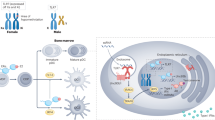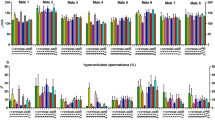Abstract
SPECULATION that immunological means could be used to control the sex ratio in mammals began when Eichwald and Silmser1 provided evidence for a Y-linked histocompatibility antigen. Feldman2 and Sachs and Heller3 initially suggested that serum from inbred females immunised by skin from males of the same strain (and assumed to contain antibody specifically directed against the Y antigen) might selectively impair the fertilising ability of sperm containing the Y chromosome. Testing of this hypothesis was hampered by lack of adequate systems for demonstrating and assaying H-Y antibody in the sera of immunised females. Consequently experiments designed to examine the possibility of immunoselection of gametes have until now all been carried out in vivo, and have involved determining the sex ratio of progeny from female mice that had rejected skin grafts from males of the same strain4–6.
This is a preview of subscription content, access via your institution
Access options
Subscribe to this journal
Receive 51 print issues and online access
$199.00 per year
only $3.90 per issue
Buy this article
- Purchase on Springer Link
- Instant access to full article PDF
Prices may be subject to local taxes which are calculated during checkout
Similar content being viewed by others
References
Eichwald, E. J., and Silmser, C. R., Transplantn Bull., 2, 148 (1955).
Feldman, M., Transplantn Bull., 5, 15 (1958).
Sachs, L., and Heller, E., J. natn. Cancer Inst., 20, 555 (1958).
Hauschka, T. S., Grinnell, S. T., Meagher, M., and Amos, D. B., in 13th Symposium on Fundamental Cancer Research, Genetics and Cancer, 271 (University of Texas MD Anderson Hospital and Tumor Institute, Austin, Texas, 1959).
McLaren, A., Transplantation, 3, 259 (1965).
Lappé, M., and Schalk, J., Transplantation, 11, 491 (1971).
Goldberg, E., Boyse, E. A., Bennett, D., Scheid, M., and Carswell, E. A., Nature, 232, 478 (1971).
Scheid, M., Boyse, E. A., Carswell, E. A., and Old, L. J., J. exp. Med., 135, 938 (1972).
Bennett, D., Goldberg, E., Dunn, L. C., and Boyse, E. A., Proc. natn. Acad. Sci. U.S.A., 69, 2079 (1972).
Long, J. A., and Mark, E. L., The Maturation of the Egg of the Mouse (Carnegie Institution, Washington, 1911).
Fellous, M., and Dausset, J., Nature, 225, 191 (1970).
Monesi, V., Expl Cell. Res., 39, 197 (1965).
Koo, G. C., Stackpole, C. W., Boyse, E. A., Hämmerling, U., and Lardis, M. P., Proc. natn. Acad. Sci. U.S.A., 70, 1502 (1973).
Author information
Authors and Affiliations
Rights and permissions
About this article
Cite this article
BENNETT, D., BOYSE, E. Sex Ratio in Progeny of Mice Inseminated with Sperm treated with H-Y Antiserum. Nature 246, 308–309 (1973). https://doi.org/10.1038/246308a0
Received:
Issue Date:
DOI: https://doi.org/10.1038/246308a0
This article is cited by
-
Pre-implantation development of cattle embryos produced from fresh bull semen enriched for X- chromosome-bearing spermatozoa using a monoclonal antibody
Veterinary Research Communications (2023)
-
Tentative identification of sex-specific antibodies and their application for screening bovine sperm proteins for sex-specificity
Molecular Biology Reports (2014)
-
Sex Determination of Bovine Embryos Using H-Y Antibodies
Acta Veterinaria Scandinavica (1989)
-
Identification of a male-specific (H-Y) antigen on the flagellar plasma membrane of ram epididymal spermatozoa
Human Genetics (1987)
Comments
By submitting a comment you agree to abide by our Terms and Community Guidelines. If you find something abusive or that does not comply with our terms or guidelines please flag it as inappropriate.



